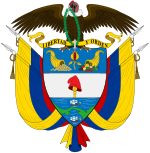
Back حرب الألف يوم Arabic Guerra de los Mil Díes AST Mingünlük müharibə Azerbaijani Krieg der Tausend Tage German Guerra de los Mil Días Spanish Tuhannen päivän sota Finnish Guerre des Mille Jours French Cogadh an Mhíle Lá Irish Cogadh na Mìle Làithean Scots/Gaelic מלחמת אלף הימים HE
You can help expand this article with text translated from the corresponding article in Spanish. (June 2013) Click [show] for important translation instructions.
|
This article needs additional citations for verification. (May 2011) |
| History of Colombia | ||||||||||||||||||||
|---|---|---|---|---|---|---|---|---|---|---|---|---|---|---|---|---|---|---|---|---|
 | ||||||||||||||||||||
| Timeline | ||||||||||||||||||||
|
||||||||||||||||||||
|
| ||||||||||||||||||||
The Thousand Days' War (Spanish: Guerra de los Mil Días) was a civil war fought in Colombia from 17 October 1899 to 21 November 1902, at first between the Liberal Party and the government led by the National Party, and later – after the Conservative Party had ousted the National Party – between the liberals and the conservative government. Caused by the longstanding ideological tug-of-war of federalism versus centralism between the liberals, conservatives, and nationalists of Colombia following the implementation of the Constitution of 1886 and the political process known as the Regeneración, tensions ran high after the presidential election of 1898, and on 17 October 1899, official insurrection against the national government was announced by members of the Liberal Party in the Department of Santander. Hostilities did not begin until the 11th of November, when liberal factions attempted to take over the city of Bucaramanga, leading to active warfare. It would end three years later with the signing of the Treaty of Neerlandia and the Treaty of Wisconsin. The war resulted in a Conservative victory, and ensured the continued dominance of the Conservative Party in Colombian politics for another 28 years. Colombia's political structure as a unitary state has not been challenged since.
As an international conflict, the war extended into Ecuadorian and Venezuelan territories. Conservative and liberal factions of those two countries, as well as of Guatemala, El Salvador, and Nicaragua, backed their respective parties within Colombia. American interests in the Panama Isthmus led to an American intervention and naval deployment in Panama (then part of Colombia) under the guise of upholding the Mallarino–Bidlack Treaty.
With an estimated 100,000 to 180,000 fatalities, about 2.5–3.8 percent of the nation's population at that time, the conflict was the deadliest and most destructive civil war in the history of Colombia. It led to severe economic, political, and social repercussions for the country, including a partial collapse of the nation's economy, continued governmental instability, and the eventual loss of the Department of Panama as an incorporated territory of the republic in 1903.
- ^ Waiss, Óscar (1954). Nacionalismo y Socialismo en América Latina. Prensa Latinoamericana, pp. 17. esta cifra carece de fundamento e implicaría prácticamente la perdida total de las fuerzas de combate de ambos bandos.
- ^ http://guerraalvg.blogspot.com/ | In Spanish, “Guerra de los Mil Dias”
- ^ BBC. "Colombia Timeline". Retrieved 11 May 2016.
